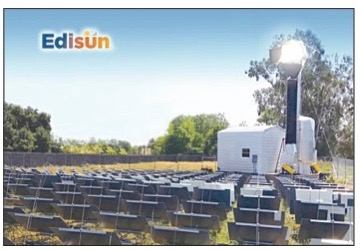The Natural Energy Laboratory of Hawai`i Authority has been transformed in the few years since its former executive director, Ron Baird, departed. At a meeting of the NELHA board last month, presentations by prospective tenants suggested the state-owned facility, now under the direction of Greg Barbour, might be returning to its mission of giving a leg up to developing energy technologies.
In the first case, Apparent, Inc., based in Novato, California, is proposing to build an ice plant powered by photovoltaic panels on about 10 acres of mauka land at NELHA, near Queen Ka`ahumanu Highway. The company, led by former Google executive George Salah, is a pioneer in the development of smart grids and microinverters.
In describing the proposal, Casey Francis, Apparent’s regional account manager for Hawai`i, explained the decision to make ice.
“We got involved in Hawai`i when we started looking at the energy costs here. … It’s crazy for a first-world country to be paying third-world prices.” By using the Apparent technology to make ice – “an energy intensive process,” he noted – Apparent “wants to showcase what we can do with intelligent grid management.”
In addition to making ice, which would be sold through a local grocery chain, Francis said, “we would like to develop additional thermal technologies, such as freezing ice with nighttime rates and then using that to augment air conditioning.”
Initially, the ice would be made with potable water from one or more of the desalination plants at NELHA. But, Francis added, “in 10 years we’d like to be making our own desalinated water.” With NELHA itself already exceeding its allowed draw on county water, “purchasing county water is not really an option,” he noted.
Although at the outset, there would be no desalination of seawater, the plant would still draw on deep, cold seawater to chill the water source used for ice. “If we can cool with deep seawater,” Francis said, “we can look at a 20 to 30 percent energy cost reduction by cooling water before it goes into ice production.”
Overall, he said, “we’re looking at a levelized cost of energy that’s less than half of what everybody else is going to be paying.”
The NELHA board gave its unanimous approval in concept to Apparent’s proposal. The next step will be for the company and NELHA to work out details, which will then be brought back to the full NELHA board for final approval, expected sometime this spring.
Goodbye Sopogy, Hello Edisun
The NELHA meeting was held in the Gateway Center, the futuristic set of buildings erected at the entrance to the sprawling NELHA acreage. Immediately south of the complex lies a field of abandoned dreams – about four acres covered with mirrored troughs, all that remains of the ambitious project of Sopogy to generate energy using concentrated solar power.
Sopogy, led by Darren Kimura, was troubled from the get-go. By 2014, no one was even pretending that it could produce 500 megawatts of power, much less the two MW originally promised.
Now a new company – Edisun Heliostats, Inc. – is promising to deliver what Sopogy could not, albeit on a more modest scale. According to Laurence Sombardier of the NELHA staff, Edisun may be able to use some of the infrastructure Sopogy left behind. “They won’t be using the mirror troughs,” however, she added. “We would have to sell those, either for scrap or salvage.” What Edisun would use would be the building, the interconnections, and footings, so there would be “minimal construction” with the new tenant, she said.
Peter Stricker, in charge of business development for Edisun, gave the board more details about the proposal, which he described as a “solar battery demonstration project,” able to dispatch renewable energy both day and night at a lower cost than fossil-fuel-generated power or photovoltaic plus batteries.
This technology, he continued, “is the only renewable generation technology that can take extra power from the grid and return it when needed.”
To date, there has been one 25 kilowatt project in Pasadena, which, Stricker said, “demonstrated the first-ever day and night production. Silent. No pollution. Super modular and cost-effective even in the first project we built.”
The key to the energy storage system isn’t a traditional battery, but instead a vessel containing locally sourced rocks. Reflected heat from the four acres of sun-tracking mirrors – the heliostats – is received by a 40-foot-high tower and conducted to the stones, where it is stored. The heat is used then to power a high-efficiency Stirling engine, producing electricity for hours after the sun has set.
“The energy storage vessel is filled with rock and high temperature,” Stricker said, “and you can get a lot of energy in a fairly small container.”
Edisun wants to work out an arrangement with NELHA that will trade generated power for at least a partial rent offset, with details to be worked out in coming months. “We want to generate $100,000 to $150,000 a year in combined lease revenue and energy savings for NELHA,” Stricker said.
Even at full production, though, it would only provide about a quarter of the energy NELHA needs to power its pumps, said Sombardier.
“If the do 100 kilowatts, that’s 1 million kilowatt hours per year,” she said. “This would provide 100 kilowatts over eight hours, so that’s maybe one fourth of what is needed.”
Barbour estimated the most Edisun could supply would be about 10 percent of NELHA’s daily load.
With the unanimous blessing of the NELHA’s Research Advisory Committee, the board gave the project approval in concept. Stricker said he hopes to come back with a proposal for the final go-ahead early this year.
— Patricia Tummons
For Further Reading
Environment Hawai`i reported on the now defunct Sopogy project in July 2008: “Sopogy Spurns SPRBs in Push to Get Federal Tax Credits for NELHA Plant.”
The article is available to read free of charge at our website, http://www.environment-hawaii.org.


Leave a Reply